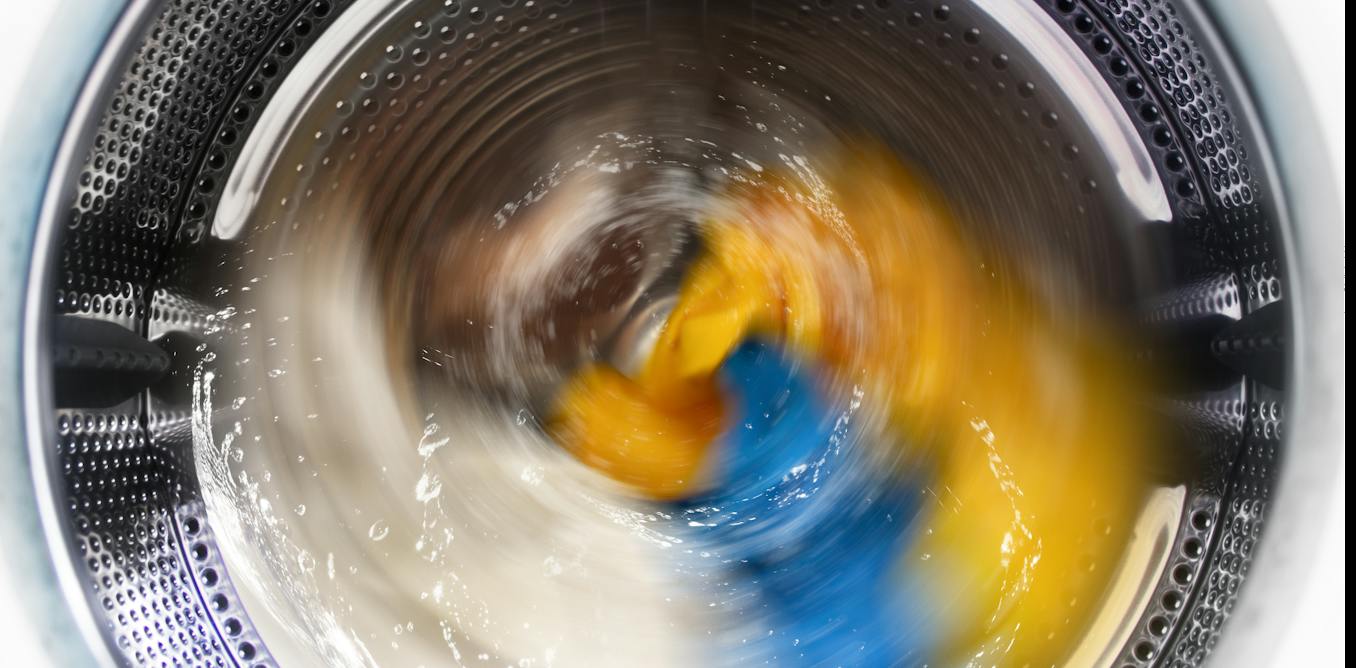The most common microplastics in the environment are microfibers—plastic fragments shaped like tiny threads or filaments. Microfibers come from many sources, including cigarette butts, fishing nets and ropes, but the biggest source is synthetic fabrics, which constantly shed them.
Textiles shed microfibers while they are manufactured, worn and disposed of, but especially when they are washed. A single wash load can release several million microfibers. Many factors affect how many fibers are released, including fabric type, mechanical action, detergents, temperature and the duration of the wash cycle.
So now that microplastics are the new hotness, industry is going to run the same plays they did when climate change became critical: blaming and shaming us for their mistakes, and trying to sell us more stuff to work around the problem they created.
I’d love a new washer and dryer, but I live in an apartment and don’t get a choice and I can’t buy a house because housing is now an investment vehicle. I’d love to hang out my clothes to dry, but because we’ve gutted healthcare, social services and housing, they get stolen by homeless and/or addicts. I’d love to not have to wash clothes as often, but I have to go into the office and look “presentable” because we can’t have commercial real estate lose value by having people work from home.
How about we stop shaming people and bust the proverbial balls of capitalism instead?
Ooooh sorry we can’t make money doing that, so…
I get the sentiment, and you’re not wrong! Just wanted to point out that you don’t need a clothes line, a collapsible drying rack will work great! You can also avoid synthetics when possible, and more people should. Not saying you have to, but synthetics tend not to last as long because they shed so much, among other reasons. Most synthetics are some derivative of plastic, and others are awful environmentally at production. Plenty of alternatives feel nicer and last longer than polyester for example. Avoid a synthetic blend flannel or sweater, buy 100% cotton or another natural fabric. Or try a tencel/cotton blend for softness if you want! Your clothes will last longer, look better, and fit nicer. There’s a reason that jeans from the 70s are still wearable while the $300 designer stretch jeans from Nordstrom start to pill after a few wears/washes and lose their shape and form. Real Denim is just tightly woven cotton yarns.
All great advice but I want to single this out:
You can also avoid synthetics when possible, and more people should.
The same issue applies to this as it does to most things, groceries springs to mind.
Just like with food where the fresh, healthier food options are often more expensive, the same goes for better made and single material made clothing.
The boots theory is a great example of what I mean.
The reason that the rich were so rich, Vimes reasoned, was because they managed to spend less money. Take boots, for example. … A man who could afford fifty dollars had a pair of boots that’d still be keeping his feet dry in ten years’ time, while a poor man who could only afford cheap boots would have spent a hundred dollars on boots in the same time and would still have wet feet.
That’s not necessarily true though when it comes to single material fabrics these days believe it or not! You can buy 100% cotton at a lower price point than lots of synthetics. Pick a store really. For example Old Navy is pretty cheap - they sell 100% cotton shirts, denim, shorts, etc. they also sell synthetic blends, and the pricing is more a function of style than anything. Jump to a higher tier like JCrew - same is true. Nordstrom. Bloomingdale’s. Designer boutique. Hell look at jeans. You can get full denim 501s and wrangler on the same shelf as synthetic, same brand and price point. You can get incredibly well made Flanels that are cotton/tencel blends from brands like Patagonia, kuhl, or Fjallraven, or you can get a 60/40 poly/cotton blend from faherty for more money. And in all these cases, what holds true is they’ll last you longer, no matter what price point you picked.
It also swings the other way where you can buy much more expensive 100% cotton items at a huge markup over synthetics. Look at reigning champ as a good example - same cotton everyone else uses, huge markup for reasons that their customer base feels are fair enough to keep paying for their stuff. You can also buy synthetics at a huge mark up way over those already marked up cottons. Many designer brands want you to wrap yourself in a 35% polyester, 30% spandex sweatshirt for $400.
One caveat is that in general, finding single material fabrics is all around more difficult for women than men, mainly as a function of style trends. But even that’s swinging the other way currently.
I don’t believe it. In part because it was not my experience when I was financially destitute and also because it’s not what I see now.
There may be some options at places like Old Navy that are inexpensive but fast fashion is just trading one devil for another.
Personally I think everyone should thrift as much as they can and avoid buying new when/where possible.
You not believing it doesn’t make it untrue. Where do you shop? What do you buy? Find me a reputable store that doesn’t carry non-blend fabrics, and I’ll find you one around the same price point that does. Nobody suggested you had to go to Old Navy, in fact I used it to demonstrate that even cheap places (Old Navy is all about cheap) have non synthetic options. They’re a baseline that holds true as you advance to just about every price point.
Like the joke about the airplane their point was clearly over your head. ✈️🤣
There are no points on a circle my friend.
You not believing it doesn’t make it untrue.
It does not, we’re both sharing anecdotal information.
Where do you shop? What do you buy?
I don’t buy a lot of clothes now, most of my clothing is several years old at least. I buy what feels comfortable, that I like the look/design of and that seems to be well made.
Find me a reputable store that doesn’t carry non-blend fabrics, and I’ll find you one around the same price point that does.
I never said d stores don’t carry non-blend fabric clothing, simply that disadvantaged portions of the population often don’t have the luxury of choice others do and that they are stuck in a system designed to keep it that way.
Nobody suggested you had to go to Old Navy, in fact I used it to demonstrate that even cheap places (Old Navy is all about cheap) have non synthetic options.
You did not, and I never said you did. I pointed out that the cheap example you used was fast fashion, which many cheap stores are. Which was an ironic choice on your part because fast fashion could be a poster child for the boots theory.
They’re a baseline that holds true as you advance to just about every price point.
Yeah, I saw your other examples of places like Patagonia which, again, is ironic because that could be the other side of the boots theory representing what “rich” people would buy.
It’s like you didn’t even read what I posted originally. I think you should check your privilege.
we’re both sharing anecdotal information.
We are not, yours in anecdotal, mine can be verified and duplicated.
disadvantaged portions of the population often don’t have the luxury of choice others do and that they are stuck in a system designed to keep it that way.
And I pointed out that every price point has these options, and offered to demonstrate it. Again not anecdotal. Unless you cannot buy clothes at all, this is not an honest assessment. You “don’t believe it”, but it is true. If you cannot afford to buy clothing at all, this entire thread doesn’t apply to you.
Yeah, I saw your other examples of places like Patagonia which, again, is ironic
That is not what irony means. Saying that a brand where the average price of a new item is $20, and a brand where the average price is over $100 both have single fabric options is not ironic. It’s data validation.
You’re complaining to complain and/or arguing to argue.
More people need to read the millionaire next door. It applies to health as well. Spend a little more on real cuts of steak, chicken, pork, etc and you will be healthier and eat less. Don’t have time to cook you say? There are these wonderful thing called an instant pots and crock pots. They can do the cooking while you do other stuff. Hit the clearance rack in the meat department and/or pay $60/year for Costco where that $60 will save you more money than you can imagine.
Another attempt to take a problem that huge corporations are causing and trying to push it on people. This is like the whole “turn your thermostat down X degrees to go green” when like 10 companies are responsible for killing the planet.
Take your bike to work every day in the rain and snow, so that it can compensate for 30 sec of private jet flight
Im bored at work, and you’ve given me a mathematical itch to scratch.
A quick search tells me that a liter of gasoline being burned emits 2.3 kg of CO2. Another quick search, after digging through a few weasel words, tells me a liter of jet fuel emits 3.16 kg of CO2 when burned.
I ride a motorcycle (975 Nightster for reference) to work most of the time, and it gets 100 km on 5 liters pretty easily. Riding to work and back is about 40 minutes, and a total distance of about 33 kilometers round trip.
A Learjet 45 Apparently uses 580 liters per hour.
For me to ride to work, I use ~1.65 liters of gasoline which works out to 3.8 kg of CO2.
A single four-hour flight on the aforementioned private jet is 2,320 liters of jet fuel, which is 7,331 kg of CO2. To offset that, I’d need to ride my bicycle or walk to work for 1,929 days or approximately 7 years.
Dont buy polyester and clothing companies might stop making it. Capitalism based climate change is a 2 way street.
Some things that are needed to exist in a society are created in a very environmentally unfriendly way. People don’t have the choice to just not participate in the economy.
Dont buy plastic clothes.
Dammit I’ll have to return all my Hefty brand panties
Adidas recycled plastic clothes won’t last.
Tl:dr - it says that you need to disregard the premise in the headline and demand that corporations (that pump more microplastics into the environment in an hour than you and your extended family could in 300,000 lifetimes) KNOCK THAT SHIT THE FUCK OFF.
We should all just stop buying shitty products from shitty companies.
Over the last 10 or so years I eliminated all plastic fibres from my warderobe almost entirely. Problem almost solved. Industry and politics: too little, too late. Again.
I tried to read the article, but it was a struggle - I skimmed bits. But, I’m pretty sure it never suggested reducing the amount of plastic in your clothes as an option.
Because reducing the amount you buy is not an option, per capitalism.
An example from the debate around climate change: Plan cities that don’t require driving? Bad. Replace cars we already own with EVs? Good.
Reducing the amount you buy doesn’t reduce the particles shed during wearing and washing.
But of course buying less overall, and as much second hand as possible, is always the better option not just for clothes. And some skills in mending your clothes so you don’t have to throw them away just because of a broken zipper or a ripped seam.
Best investment: a sewing machine.
Cotton, wool, linen, silk, hemp, bamboo, etc…
Even Rayon/Viscose is “decent”, as it’s a pulp and paper product.
Downside is that it is much, much easier to find near-100% natural products as a guy than as a girl. A lot of clothing for women come only in synthetic fibres, and the struggle for my wife is very, very real.
And even as a guy, you have to be aware of mixes. Many fabrics may be up to 95% of one thing (cotton, etc.), but then have a half-dozen synthetic additives (for additional physical attributes, like stretchiness) that then contribute to those microfibres that don’t easily break down.
Even as a hard Atheist, I frequently (and jokingly) turn down clothing due to the fact that it violates Leviticus 19:19.
As a fellow atheist, I love your bible argument! 😂
I can imagine it’s more difficult for women, but as a man I haven’t really looked into that. And as an old man dressing more on the “formal” side it might be easier to find clothes, than younger “athleisure” people.
The hilarious bit is when I see salespeople wearing visibly obvious Christian symbols (a cross on a necklace, for example) who get either visibly confused at my reference, like they have no clue of that passage or what it says, or get visibly offended that I am (ostensibly) living my life biblically, like a good Christian should.
I was even once asked why I was not wearing a cross. Enraged the dude by telling him that all iconography and symbols - like a cross - is nothing more than a golden calf.
True question: bamboo, rayon, viscose, tencel, etc… are “natural” product artificially polymerized. Aren’t these similar to plastics in the sense of a polymerized chain?
Does it degrades faster than “traditional” plastics? I’ll have to look into that.
And I otherwise completely agree with you. I’m now only buying if cotton/linen/wool. However hard to find clothes made 100% with these. :(
Most of my artificial fibre clothes are for exercise, what did you do around that? I value the sweat wicking, quick drying properties.
Thanks in advance for your help!
Try linen (even comes in jersey knit!)
where do you find lighter linen clothing? everything ive worn thats linen has been the thick, canvasy type
I buy from a German second hand online shop which has a decent selection most of the time. But you often have to be patient if you want something specific. It’s not like “I need xyz tomorrow, let’s buy something”, but more “It’s January, but will be hot again in summer. Let’s see if there’s a nice shirt and summer suit on offer within the next 20 weeks”
Yeah, I will not give up my knitted elasto-poly-whatever shirts, I need them to survive on the production floor. Cotton would kill me lol
Same, everything I have is either cotton or wool.
It was partially for sustainability, and partially because plastic clothes feel horrible, irritate my skin, and suck at wicking moisture.
What materials did you replace them with?
Linen and wool whenever possible. Or cotton, which has some issues (needs a lot of water to grow, gets damp very easily - sweat and rain! - and takes a long time to dry)
TL;DR: microplastics bad, do less laundry. Can’t believe I wasted my brain reading this.
Yes, my cotton shirts and pants are the problem. Yup.
I used to work for a company that made precast concrete parts. One of the things they made was the faux stone walls that go around some fancy neighborhoods. They are poured into a mold, and one side of the mold has a plastic insert for the stone pattern. The plastic inserts, which are larger than any piece of plastic in your house, are used to make one wall and then they are tossed. This is one small company, and it’s an example of the plastic waste we don’t see or even think about, while we are told that our clothes are being washed wrong.
They said synthetics, not natural fibers.
Right, but they also said “washing clothes”.
We installed one of these to keep micro plastics and fibers out of our septic system.
Works well as far as we can tell.
Stop buying plastic clothing?
Baloney. Everything we eat, touch, wear- is contaminated or made with plastics. Has been since the very begining of the plastics industry. Massive massive overuse and over production. From baby bottles to the syringes you inject your tranq with- plastics.
Havent worn synthetics in years.
Use a front loading washing machine.
Excuse me? The type that breaks down faster vs top loading?
deleted by creator
Dont











